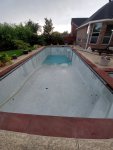You may have accidentally invented a new way to buy some time when people have large liner rips.
Awesome job and pretty cool screwup.
After the initial panic, (I hear ya, I would have needed fresh pants myself) I would have kissed it goodbye and cut the tarp with a Sheetrock knife at the drains, the pump, the hose, the stairs and anywhere else I could get a fold or flap without worrying about cutting the liner. It would have taken a while but it would have drained like cutting the actual liner just the same.
Whatever parts of the tarp you saved will come in handy for something else I’m sure.
Awesome job and pretty cool screwup.
After the initial panic, (I hear ya, I would have needed fresh pants myself) I would have kissed it goodbye and cut the tarp with a Sheetrock knife at the drains, the pump, the hose, the stairs and anywhere else I could get a fold or flap without worrying about cutting the liner. It would have taken a while but it would have drained like cutting the actual liner just the same.
Whatever parts of the tarp you saved will come in handy for something else I’m sure.


